Part 3: A Lost City, Cross on a Mountain and the James Bond of Bagpipes
Follow my Greek adventure in Rhodes
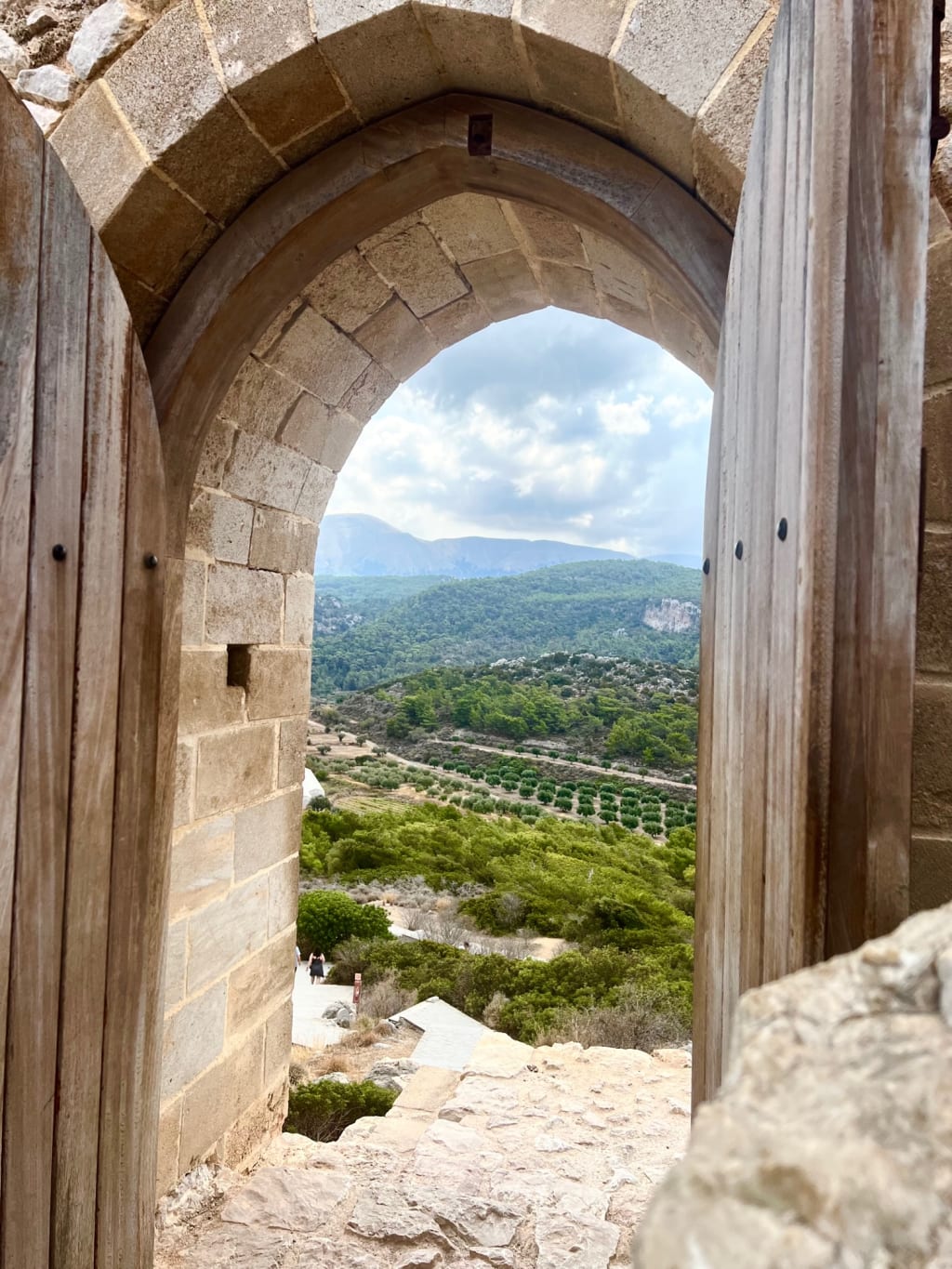
We woke up slightly hungover and certainly dehydrated. Not a great start to a long day out but breakfast did revive us somewhat. Waiting out front for the coach, as seemed a common and welcome theme by now, I was greeted by an affection craving black cat with little white paws and a crooked ear. He jumped gingerly into my lap and his scrawny rear end rose high with every stroke. T dubbed him “Cotton Socks”, which suited him handsomely. He would be there to escort us to the shop upon our return, as any gentlecat might assume was his duty, though wouldn’t be as helpful as he thought considering we had to avoid stepping on him multiple times.
The guided tour would include a visit to the ancient city of Kamiros then Kritinia Castle followed by the Embona wine village and finally Mount Filerimos. On the coach we had an enthusiastic and passionate guide, a native of the island who regaled us with stories of local History and culture. When we reached Kamiros, there was a small fee to enter (6 euros) which we deemed fair for its preservation. It was a collection of stone and marble ruins giving the outlines of what was once a bustling and vivacious community. Our guide brought it to life. Among the surviving, standing columns, the rubble and indentations, the mind lifted out of the earth the bath houses, the functioning toilets, the Acropolis, the Agora and the market.

The Acropolis was the highest point in the city where we could see the remains of the temple of Athena and the giant cistern that would have held the water for about 300 to 400 families. The Agora in the lower part of the city used to be the commercial center of the area where citizens would gather. There you could see ghe plinths upon which people voiced their ideas. Our guide did speak on the fact that this city was built by slaves. Sadly, despite being the basis for the city’s very existence, these residents would not have a voice in the square. We took a moment to ruminate on that.
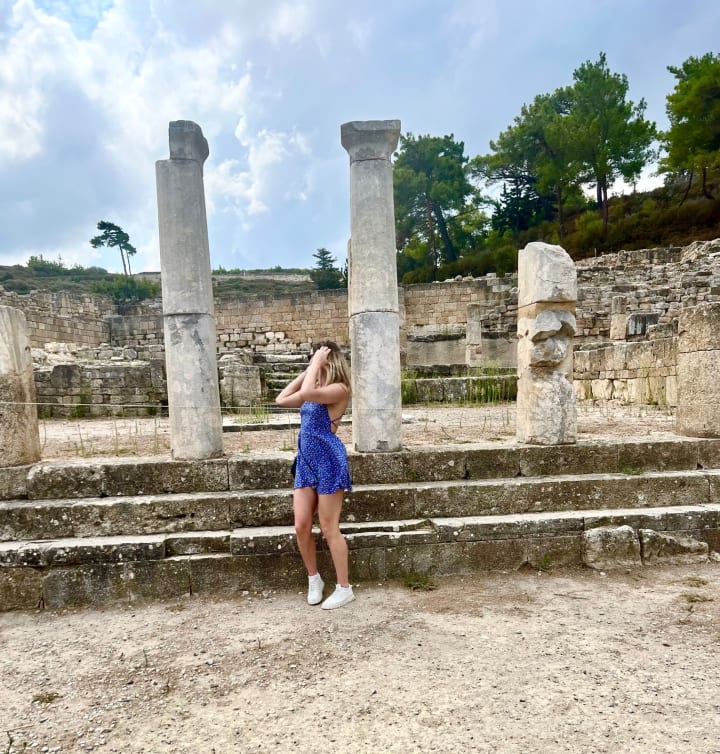
We were then left to wander the ruins on our own and were met with majestic mountain views all around and in the distance, the ocean. It was easy to see how the landscape and weather could inspire the mythic beliefs of the people who lived here. As I walked through the remains of her old temple, I felt the energy of Athena, the remnants of something once sacred here. In the excavated ruins of what were once people’s houses, I could see the way the rooms were split and imagined for a moment the lives of those who once called them home. How they might duck in to escape the heat of the midday sun. How they might venture out to cool off in the bathhouses.
Why did they leave? We were informed that the inhabitants moved to the new city of Rhodes in 406 BC, leaving Kamiros abandoned and eventually lost. We returned to the rocky outcrop overlooking the lost city and were off to our next stop, Kritinia's castle. These are the ruins of a large, Venetian castle high up on one of the hills. It was set up by the knights of St. John because of its strategic views of the Aegean Sea. Something we were soon to discover for ourselves (as can be seen best in the cover photo for this post).
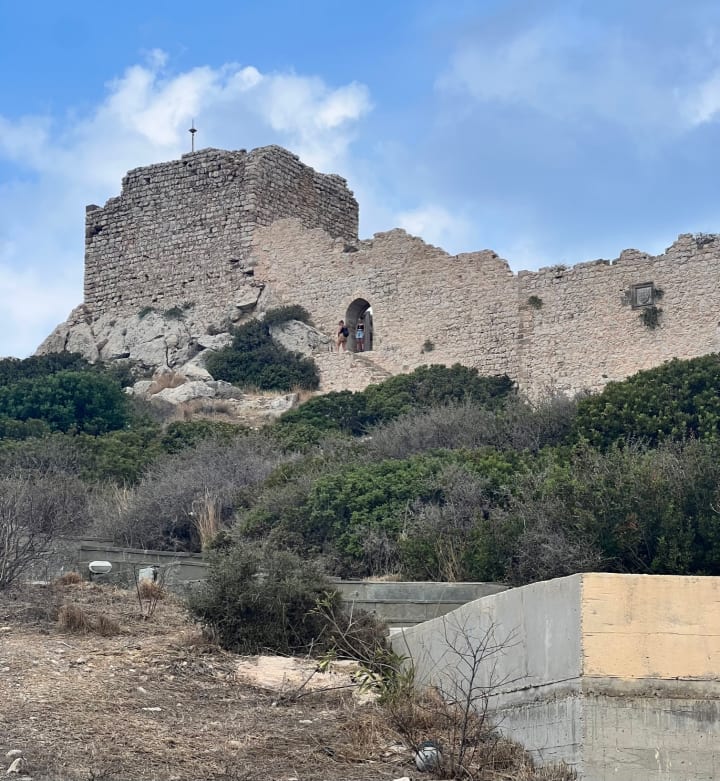
We reached the lower levels of these majestic ruins, that offered stunning views already, and prepared for our ascent to the top. This was when T’s heart began to play up, usually a sign for her to sit down and rest a while. She told me to go on ahead, and the guide did warn that anyone uncomfortable with this bit of the climb could hang back at the café. T assured me she'd be fine, she'd be there waiting for me. T was right to hang back as the climb from the lower to the upper levels of the castle became increasingly steep and difficult to navigate. I myself almost slipped on the stone steps interspersed with gaps and missing sections that had crumbled away. You had to carefully watch for each foot and even handhold. Castles are built this way for a reason, to make it harder for intruders to conquer them.

Though the panoramic views were stunning, the surrounding visible islands were similar from a distance. Green masses of mystery, the ocean stretching for miles around. T wouldn't have missed a lot in terms of what could be seen. As I slowly made my way down, I was in for a surprise. T had made an intriguing friend. An older gentleman had also decided to hang back and asked T if she fancied some company at the café as he waited for his wife, who had also made the climb. He kindly treated T to a coffee and myself to a freshly squeezed orange juice as the four of us sat together to hear the couple’s fascinating story.

They were avid players of the bagpipes and had travelled all around the UK to perform. They had visited Rhodes 42 years ago on their honeymoon, and returned to celebrate the fact that the husband had a year later survived a brain tumour. My friend questioned if he was James Bond and he comically quipped “Could James Bond play the bagpipes?” The couple were brimming with kindness and my heart was warmed by the story of an enduring love that had overcome such hardship. It gave me hope that one day I might find the same.

As the group reconvened, I was starving and very much looking forward to the Embona wine village where we would receive sustenance. It was a sweet little village if not entirely picturesque. Included in the price of the ticket was a simple Greek lunch with a jug of wine. Lovely bread with a Tzatziki dip, a fresh, feta cheese salad followed by chicken souvlaki with rice and grapes for dessert. Unexpectedly a lone American tourist from the group joined us for lunch. A sweet and energetic lady. Before the food arrived and we became acquainted, well, I’m not proud of this particular character flaw, but I am not very patient when hungry. Suffice to say, my unintended bluntness as she offloaded the chaotic happenings of her life to us, may have offended her. We parted ways after lunch to explore the village.

There was an abundance of affordable souvenirs in the little shops. T was drawn to the painted little clay vases and pots in a more ancient looking style. We had been told Rhodes was famous for a number of things, such as the natural sea sponges and in this area particular, local flowers flavouring the honey. A sea sponge and orange blossom honey was of course first in my bundle (highly recommend as practical souvenirs or gifts). I was also drawn to the beautiful, painted ceramic pendants depicting the sign for protection against the evil eye (mati in Greek). I’d always associated this with the east, but with this symbol quite literally staring at me all over the place, I could clearly see it was also prominent in Greek culture.
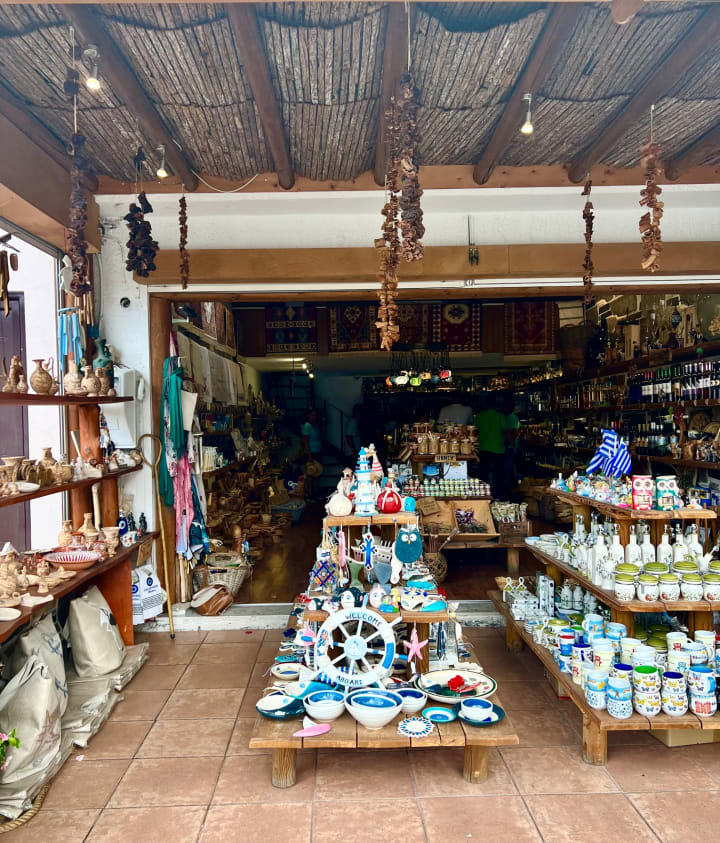
There were cute little touristy bracelets that also caught my eye. When I saw one with an infinity sign charm, I had to buy it as a surprise present for T. She loves that sign, isn’t quite sure why, maybe because it’s a symbol of how things carry on no matter what happens, the never-ending cycle of life. Finally, I wanted a Greek accompaniment to my sponge, so I picked up an olive oil soap bar, a famous element of Greek skin care. At the counter, we were greeted with more of the Greek warmth and hospitality we’d become accustomed to. A plethora of free samples were eagerly pushed into our hands. Different flavoured wines and olive oils to be tried with small pieces of bread, all delicious. When it came to making my purchases, the gentleman who had given us the samples threw in my soap bar for free.
Feeling drowsier now but in excellent spirits, we boarded the bus again to make our way to Mount Filerimos. As we observed the landscape, the guide shared several stories. We passed a number of small cemeteries, all neatly lined with Cypress trees. That’s when we learned of the Cypress tree myth. That a young man called Cyparissus, favoured by the sun god Apollo, had a pet stag he adored. When hunting he accidentally killed his beloved stag and was overcome with grief, throwing his body over it and transforming into a Cypress tree. This tree is therefore a symbol of mourning.

The view from the window then moved from myths to recent reality and tragedy. We passed masses of scorched earth and blackened trees which is where the guide began to speak passionately of the recent wild fires in Rhodes. We had heard about this on the news, hadn't been sure if the trip would even happen. This was where we learned the sad truth, of how little help had been offered by the mainland and internationally. How rescue and recovery was mainly carried out by residents and volunteers, which the guide herself had been an adamant part of. I hoped that the burned earth would give way to new life and took a moment to think of the families who’d been affected.

We reached our final stop, Mount Filerimos, site of the Filerimos monastery, built by those same knights of St. John. Upon leaving the coach we were surrounded by peacocks, sadly not as impressive as they might have been as the tour guide informed us they were now moulting. We couldn't enter the monastery itself but admired it from afar as we took the famous, cypress tree lined walk along the Via Crucis. This is a path leading to a gigantic cross on an open square, passing alters embedded with scenes depicting the Passions of Christ.
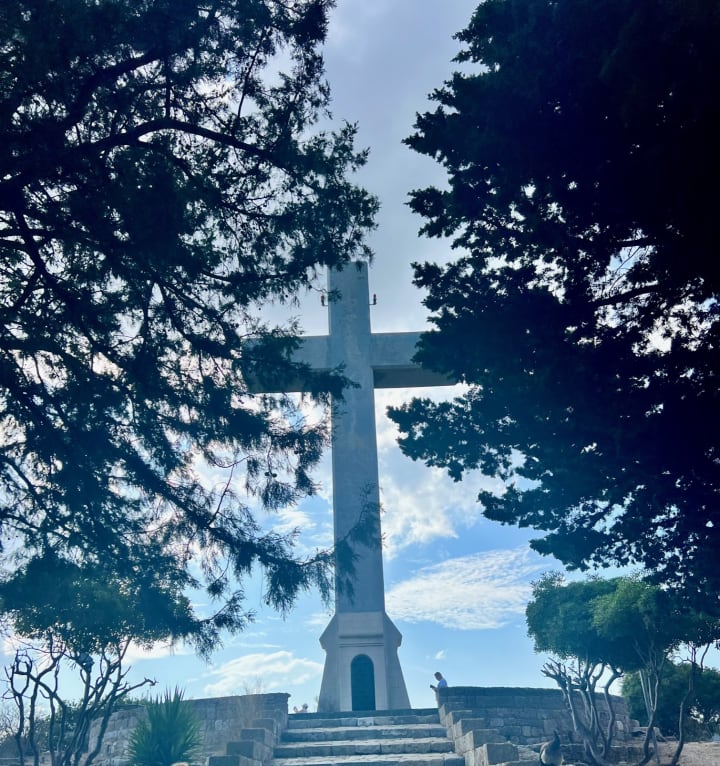
The walkway, Cross and alters were all put in place by the Italians during their occupation and the guide pointed out to us the bullet holes marking the alters, put there during the second world war. The walk and panoramic views at the cross were cinematic. You could feel the weight of so much History that had passed here, with the site itself being originally home to the Acropolis of Ancient Ialyssos and an important temple dedicated to Athena Polias.

There were goats scavenging further along as the peacocks and peahens continued their own business. I saw an English man in our group pick up some of the fallen feathers as a keepsake. After taking an abundance of photos near the cross, I spotted a building nearby we hadn't yet explored and suggested we take a look before heading back. Inside was the eerie calm and quiet of an orthodox chapel. Curiousity satisfied we headed back down the Calvary path to the coach, heading home for more wine and tranquility.

Zorro greeted us upon our return, posted on the welcome mat at the entrance as if it was his hotel and everyone trying to get in was being inconvenient. We ended the day with a sunset walk on the beach and trying the nearby, aesthetically pleasing Italian restaurant. Not on theme for being in Greece but delicious all the same.
*
*
Follow along and stay tuned for the final part of my Greek adventure! Any hearts appreciated if you're enjoying my journey so far. Don't hesitate to let me know your thoughts in the comments as well as anything else you might like to see written about!
Final part:
Here's parts 1 and 2 if you missed them:
About the Creator
Nessy Writer
A freelance writer of all sorts sharing it out with the world. Poetry, prose, advice, reviews and travel writing.
If you want to show your support and see more please follow me on Twitter: Nessywriter





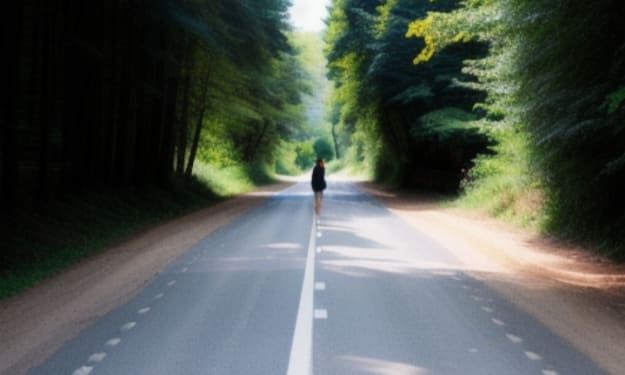
Comments
There are no comments for this story
Be the first to respond and start the conversation.